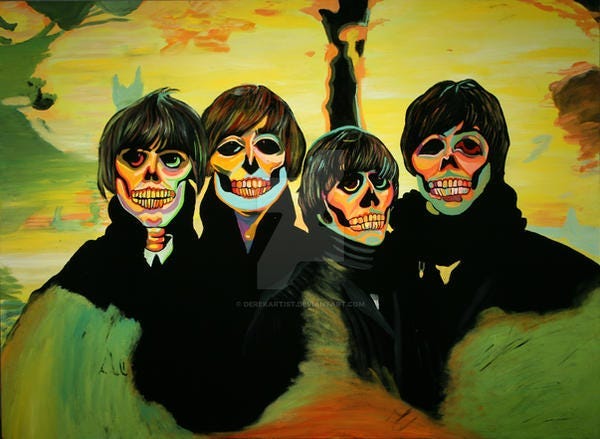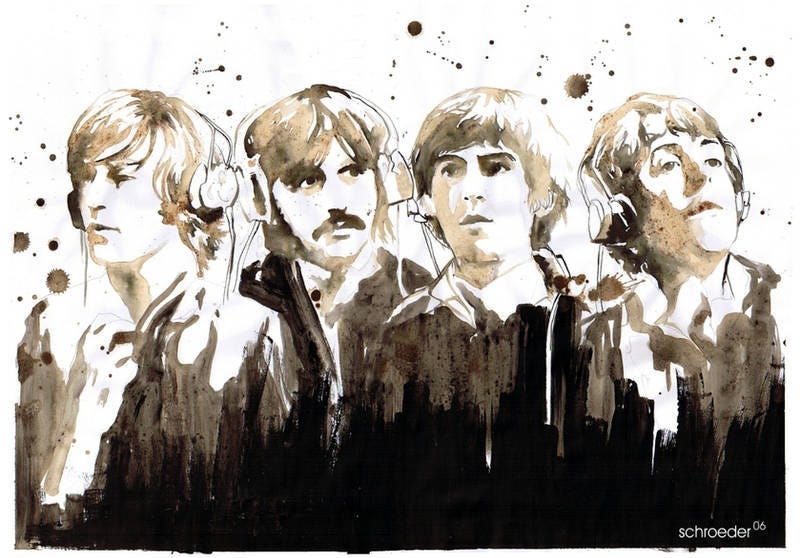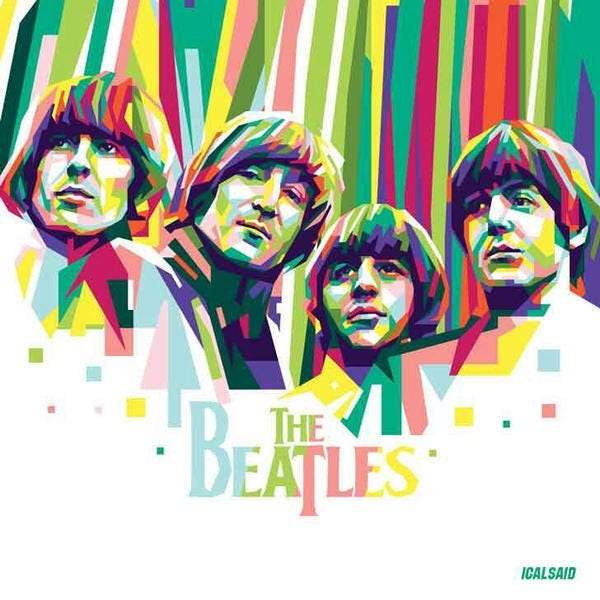The Beatles Most Hated Album Saved Their Career
The record wasn’t a low point, it’s misunderstood for reasons critics want you to ignore

In September 1964, The Beatles faced the challenge of writing and recording “Beatles For Sale,” which was due for release in less than three months. Often seen as their worst album, it has become overshadowed by the successes of “A Hard Day’s Night” and “Help!”
Frequently labeled “bleak, dark, joyless, and uninspired,” this misleading stereotype makes it easy to miss the album’s true significance and the creative challenges the band faced — and overcame — as they evolved as brilliant songwriters.
Dismissing it as their weakest work is a misunderstanding of The Beatles creative artistic journey as they explored:
New musical and lyrical themes.
Experimented with a new genre, “Country Rock”
And bridged the gap between the group’s early pop sound and the ambitious direction of “Rubber Soul.”
If we move beyond the traditional negative narrative, the record isn’t a low point; it’s a pivotal moment that helped shape The Beatles legacy and ultimately saved their careers.
The Setback of “A Hard Day’s Night?”
In the late summer of 1964, The Beatles confronted the exhausting reality of their extraordinary success. By April, they had dominated the U.S. Billboard Hot 100, claiming the top five spots, while their Ed Sullivan debut captivated 70 million viewers. Their film, “A Hard Day’s Night” set new standards for rock bands and cemented their place in music history.
The thirteen tracks on “A Hard Day’s Night” were entirely original compositions by Lennon and McCartney, marking a first for the Fab Four. This milestone in their artistic development highlighted their growth as musicians but also presented new challenges.
Contractually, The Beatles were obligated to release a new single within three months of A Hard Day’s Night.
Additionally, they had to deliver another LP to the shelves in less than four months after releasing “A Hard Day’s Night.”
Furthermore, they had another upcoming soundtrack for the yet-to-be-filmed second movie to compose.
As a result, John and Paul dedicated every free moment to songwriting to meet the relentless demands of 1964, with 1965 fast approaching.
Neil Aspinall, the Beatles’ road manager, noted: “No band today would come off a long US tour at the end of September, go into the studio and start a new album, still writing songs, and then go on a UK tour, finish the album in five weeks, still touring, and have the album out in time for Christmas.”
The band had only three weeks to record “Beatles for Sale,” which was a challenge, especially since their back catalog began to dwindle. With the clock ticking down and pressure mounting for another hit album, The Beatles faced a material shortage.
Did they find a way to deliver once again? Or was the album a sign of creative fatigue, if not laziness, cashing in on their name?
I Don’t Want To Spoil The Party…

Released on December 4, 1964, Beatles for Sale debuted at number one worldwide. Although it has been criticized in hindsight as a creative failure, this view is both misleading and objectively inaccurate.
A closer look reveals a collection of songs underscoring the strength of John and Paul’s songwriting partnership and remarkable resourcefulness.
John and Paul collaborated on most songs, with only “No Reply,” “I’ll Follow The Sun,” and “I’m a Loser” individually composed.
They explored a new genre, with Lennon dubbing it The Beatles’ country and western LP.
New artistic paths, frequently disregarded, were also forged.
The cover songs enhanced the originals, even with claims to the contrary.
Despite consisting of only seven original songs, reverting to the format before “A Hard Day’s Night,” “Beatles For Sale” deserves more recognition than it receives.
It laid important groundwork for Rubber Soul and was the first album that found them charting new territories both musically and lyrically. Far from being “retread,” the record’s first two songs show a band quickly maturing.
The Darkest Beatles Record

Lyrically and musically, “Beatles For Sale” marked a subtle yet significant shift in the band’s artistic vision. Upon its release, John famously described it as “a Beatles country and western LP.” Songs like “Baby’s in Black,” “I’m a Loser,” “I Don’t Want To Spoil The Party,” “Honey Don’t,” and “Everybody’s Trying To Be My Baby” clearly showcase this new influence.
Tracks like “No Reply” and “I’m a Loser” may draw on elements associated with country music but also reflect a folk music sensibility influenced by Bob Dylan’s growing impact on Lennon’s writing. This infusion of new ideas opened creative doors that had previously been closed.
“I’m a Loser” was the Beatles’ first overtly Dylan-influenced song. It made a bold lyrical statement for its time and offered a fresh perspective on the typical breakup song cliche.
Lennon’s lyrics, which can be seen as a precursor to the song Help, starkly contrast with the more upbeat theme of the originals that comprised A Hard Day’s Night. The introspective lines reflect vulnerability and depth:
Although I laugh and act like a clown / Beneath this mask I am wearing a frown/ My tears are falling like rain from the sky / Is it for her or myself that I cry?
I’m a loser / And I lost someone who’s near to me / I’m a loser / And I’m not what I appear to be.”
Lennon later remarked, “I’m A Loser is me in my Dylan period, because the word ‘clown’ is in it. I initially objected to that word, thinking it was too artsy-fartsy, but since Dylan used it, I thought it was acceptable, and it fit the rhyme.”
If “I’m a Loser” was a lyrical oddity for a mainstream rock act in 1964, then “No Reply” represents a radical departure from the cultural norms of rock ’n’ roll songwriting and opens the door to increasingly personal lyrics.
As Lennon noted, this was the first song he wrote that told a complete story from start to finish — a technique he would continue to explore in “Norwegian Wood (This Bird Has Flown)” and other classics, such as “In My Life” and the introspective “Strawberry Fields Forever.”
The Musical Secret Behind “No Reply”
The story of betrayal in “No Reply” is complemented by a groundbreaking chord progression and arrangement, illustrating the Beatles’ growing musical sophistication.
With its stark opening lines, “This happened once before when I came to your door, no reply,” we are immediately drawn into the story. He vividly describes others covering up her lies, “They said it wasn’t you.” Yet, Lennon’s suspicions of deception are confirmed when he glimpses her through the window, exclaiming, “I saw the light,” a phrase that captures both the literal moment and the symbolic weight of his painful realization of the truth.
The innovative chord progression perfectly fits the song’s haunting narrative of love and lies. The melody keeps us captivated through subtle yet highly effective songwriting techniques.
As Lennon sings “I Saw the Light,” the chords follow a typical A-minor to E-minor pattern, but the second time, on the word “light,” it shifts to an unexpected F-major-7th instantly grabbing our attention.
The bridge transitions to a major chord progression providing an uplifting optimistic feel, reinforcing the themes of forgiveness and devotion.
No Reply ends on an abrupt yet sonically vivid “C6 add 9” chord.
This produces a sense of uncertainty as the song closes.
In contrast, a more standard approach of concluding with a C major chord would have felt predictable even to non-musicians ears. Instead, the “C6 add 9” provides a thematic depth and poignancy.
When analyzing the “small” details, it becomes clear why the arrangements on “Beatles for Sale” are consistently mesmerizing and unique from their prior catalog. (For more Beatle music analysis check out: Unlocking the Beatle Code, A Day In The Life: Who’s the Mystery Singer? and Why Rubber Soul Matters: The Beatles Controversial Cultural Reset)
The intro of “Eight Days a Week” broke all the traditional arrangement “rules” by using a “musical fade-in,” a practice never before used, to introduce us to the iconic ascending riffs.
Even during Beatlemania, when they were exhausted, Lennon and McCartney never took their fans for granted. Despite being aware that audiences would purchase anything with the Beatles’ name attached, they continuously found ways to keep the music artistically engaging.
Although the group has been heavily criticized for repeating the “old approach” of including cover songs on “Beatles For Sale,” ultimately, it saved their careers.
How “Beatles For Sale” Saved Their Career

While “Beatles for Sale” is frequently cited as the band’s weakest album, described by critics and fans alike as uninspired and a step back from “A Hard Day’s Night,” I don’t see it quite as black and white.
For example, music critic Stephen Thomas Erlewine describes the album’s opening sequence as “bleak” and claims only a handful of “joyful” moments can be found throughout the entire LP.
I believe Erlewine and others missed the point entirely. The album’s greatest strength lies in its darker, more personal lyrics, reflecting John and Paul’s transition from youth to maturity. They express their emotional struggles instead of delivering superficial rewrites of hits like “I Want to Hold Your Hand” and “She Loves You,” focusing instead on expanding their sonic palettes.
The waltz of “Baby’s in Black” and the folk-driven confessional “I Don’t Want to Spoil the Party” demonstrate the Lennon-McCartney evolution beyond simple love songs. This transformation is particularly evident in the “bleak” tracks “I’m a Loser” and “No Reply.”
Additionally, McCartney’s “Every Little Thing” and “What You’re Doing” provide a lyrical depth that surpasses much of his earlier work.
Without this album, The Beatles’ careers would have stalled had they decided to include half-baked, unoriginal throw-away originals. Instead, they kept it a tight collection of forward-thinking tunes that, in the end, was the initial spark for “Rubber Soul” and all that followed.
The Cover Song Controversy
Instead of acknowledging the artistic strides in their songwriting, “Beatles for Sale” has faced negative attention for reverting to the format of seven originals and covers.
This was not a lazy choice but a pragmatic and thoughtful one. Their covers of “Rock and Roll Music,” “Kansas City/Hey-Hey-Hey-Hey” and “Words of Love” offer a vital counterpoint to the more serious themes of the originals. “Words of Love” is a beautiful duet by John and Paul, written by their hero Buddy Holly.
The group’s choice to include carefully selected cover songs proved an intelligent strategy. It gave them time to develop new material for “Help.” With one listen to “Help,” it’s evident they built the album on artistic advancements, which debuted in “Beatles for Sale.”
Lastly, including cover songs allowed them to reserve “I Feel Fine” and “She’s a Woman” for their late November 1964 single and the other soon-to-be-released singles including the songs “Day Tripper,” “We Can Work It Out,” “I’m Down,” and “Yes It Is.”
Is “Beatles for Sale” really the worst and most uninspired album in Beatles history, despite its artistic growth, cohesive themes, and rock ’n’ roll attitude?
‘Beaten, Worn, Bitter, Self-loathing ‘ & It’s B.S.

“Beatles for Sale” is objectively not the group’s weakest work or worst album. Instead, the Beatles’ history is often misunderstood, overlooked, and sometimes intentionally ignored.
Conversations about the band’s output before “Rubber Soul” usually focus on popular hits like “A Hard Day’s Night” and the 1963–1964 singles “From Me to You,” “She Loves You,” “I Want to Hold Your Hand,” and “I Feel Fine.” This emphasis tends to overshadow “Beatles for Sale’s” historical significance, which deserves more recognition.
Or is the real story simply a diluted narrative of an album that is “beaten, worn… bitter and self-loathing,” as critic Stephen Thomas Erlewine suggested? Clearly, Erlewine’s agenda-driven “review” distorts the album’s true creative contribution by taking it out of context.
In contrast to Erlewine’s perception, “Beatles for Sale” opened a new door of artistic self-awareness and expression, which had previously been lacking in much of their earlier work. This was utilized heavily throughout their next all-original album, “Help.”
“Help” features country-influenced guitar riffs throughout the record (“Another Girl,” “You’re Going To Lose That Girl,” “Act Naturally”). The title track and “You’ve Got To Hide Your Love Away” follow the lyrical imprint of the “Beatles for Sale.”
Musically, “Ticket to Ride’s” country-influenced harmonies and staggered drumbeat all trace their origins back to the musical risks and experimentation taken on “Beatles for Sale,” including the diversity of instruments, including timpani and Hammond organs.
‘The Mistake I Made’ — Final Thoughts
Did “Beatles for Sale” save The Beatles’ career or is that pure hyperbole? In the long run, it absolutely did by establishing new artistic benchmarks for John and Paul to build on for “Rubber Soul” and beyond. Instead of filling the album with fourteen mediocre original songs, they prioritized consistency.
John, Paul, George, and Ringo integrated a new genre into rock ’n’ roll, placing country music on an international stage. They embraced Bob Dylan’s lyrical depth and experimented with darker, more mature themes. The album demonstrated that even under immense pressure, The Beatles could deliver songs that satisfied fans while maintaining their artistic integrity.
If this is what “lazy” music sounds like, I’ll gladly embrace it and defend The Beatles’ least-respected, historically “invisible” album any day of the week.
As always, thanks for reading!
Enjoyed this piece? The author has more to share — read the original post on Rock n’Heavy and discover his work here.






Dead right, Daniel. Anyone who says Beatles For Sale is weak are merely repeating ridiculous and incorrect tropes like 'Ringo wasn't a good drummer,' or as I heard the other day on TV, 'they were hyped'.
You make brilliant points Daniel as ever. The words weak and Beatles music do not fit in the same sentence. Every album was genius.
It was on TV Sky News and they were reporting something on The Beatles or maybe Paul McCartney. I can't remember what as I got annoyed when one presenter turned to the other and said her colleague didn't like the Beatles. He replied that he didn't get the hype. They were typical no personality TV presenters trying to pretend they were being controversial and witty.